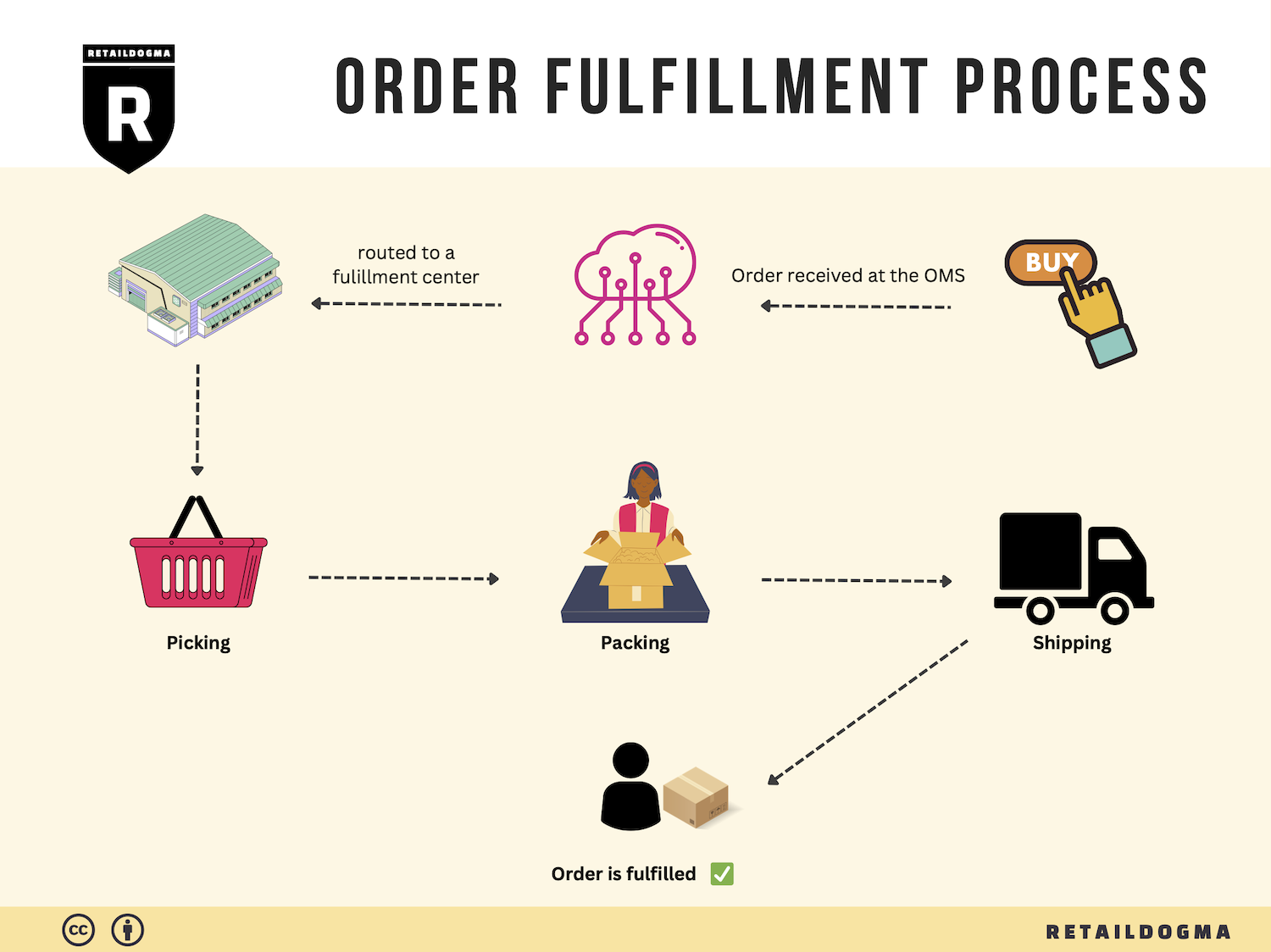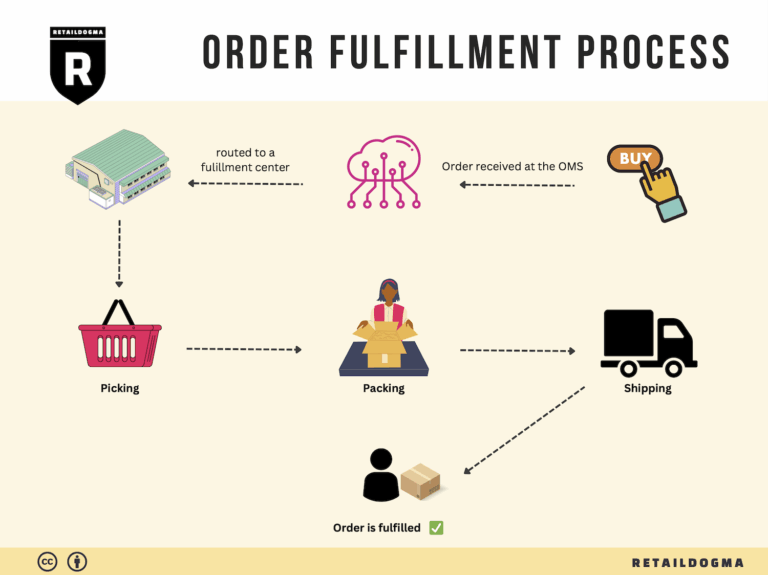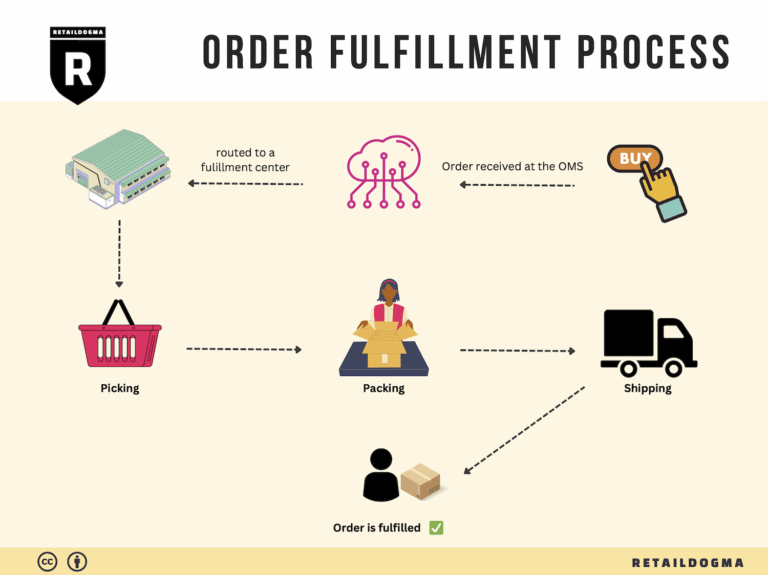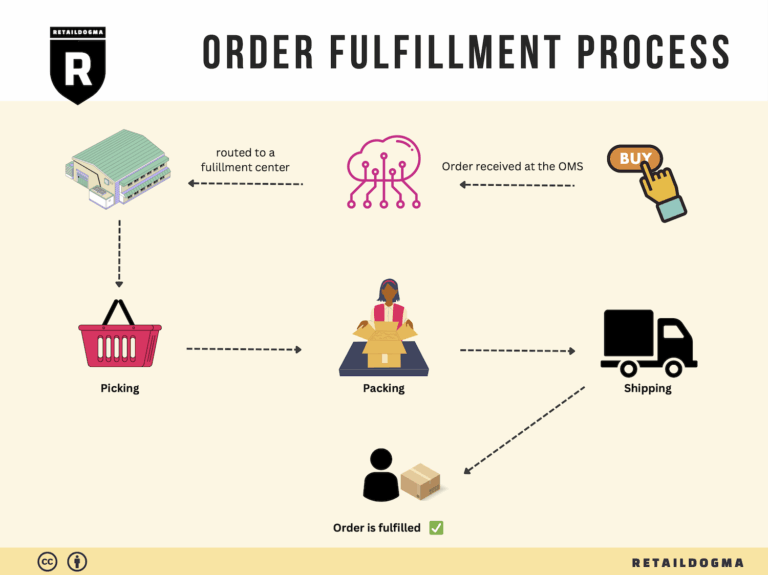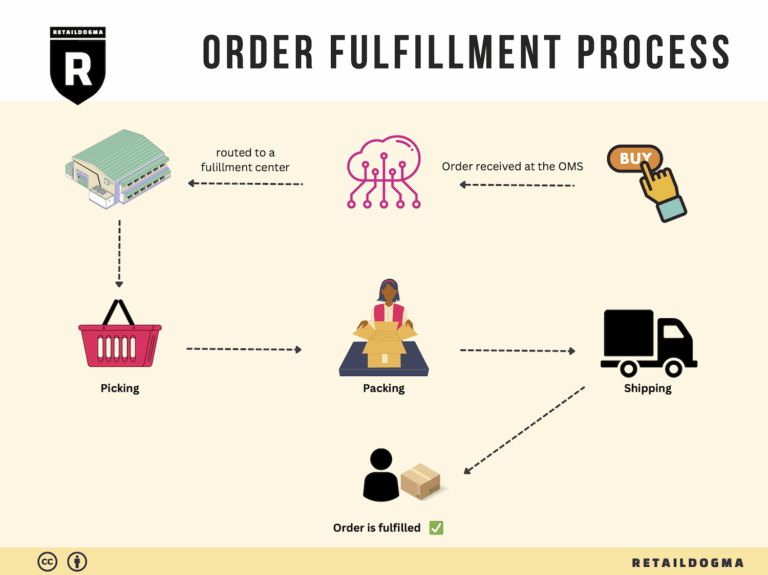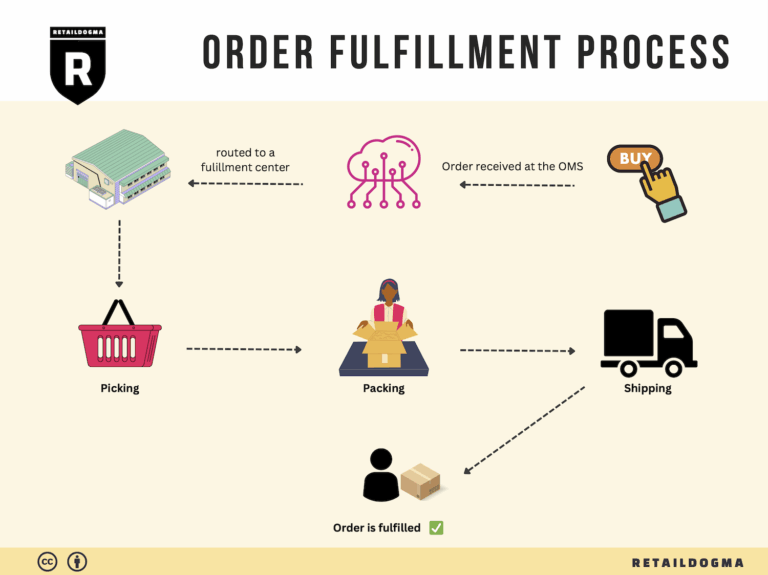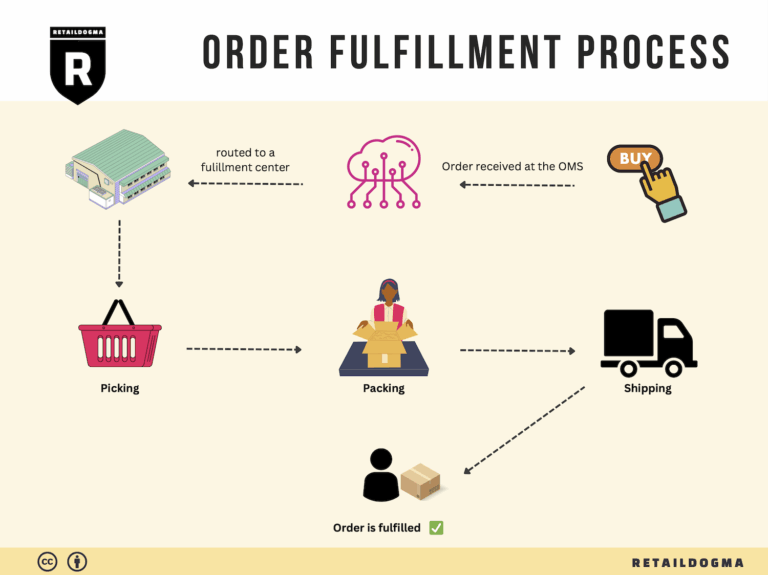Ecommerce Fulfillment Services: The Ultimate Guide (2025)
What is E-commerce Fulfillment? An Introduction for Growing Businesses
Navigating the Complex World of E-commerce Fulfillment
As an e-commerce business owner, one of the most pressing challenges you may face is managing the packing and shipping of orders. The excitement of growing sales can quickly turn into overwhelm when you realize the demands of logistics: from inventory management to timely deliveries. This is where e-commerce fulfillment comes into play, serving as a vital link between your products and your customers.
Fulfillment can be simply defined as the process of getting a product from your inventory to the customer’s doorstep. However, it encompasses much more than just shipping. It includes receiving inventory, storing products, picking and packing orders, and handling returns. As your business scales, understanding and optimizing your fulfillment process becomes crucial for maintaining customer satisfaction and operational efficiency.
This guide aims to demystify the landscape of e-commerce fulfillment, providing you with the knowledge to make informed decisions as you scale your business. We will explore various fulfillment models, including Third-Party Logistics (3PL) and Fulfillment by Amazon (FBA), detailing how each can suit different business needs.
Additionally, we will outline the core services typically offered in fulfillment, such as inventory management, order processing, shipping, and returns handling. Knowing these services will help you identify what is essential for your operations and how to leverage them effectively.
Choosing the right fulfillment partner is another critical decision that can affect your bottom line and customer experience. This guide will provide practical tips on how to evaluate potential partners, looking at factors such as technology integration, geographic location, scalability, and service reliability.
Lastly, we will discuss pricing structures commonly associated with fulfillment services, helping you understand the cost implications of different models and what to expect as you negotiate contracts.
The ultimate goal of this guide is to empower you to make smart, strategic decisions regarding your logistics. By understanding the intricacies of e-commerce fulfillment, you can streamline your operations, enhance customer satisfaction, and focus on what you do best: growing your business.
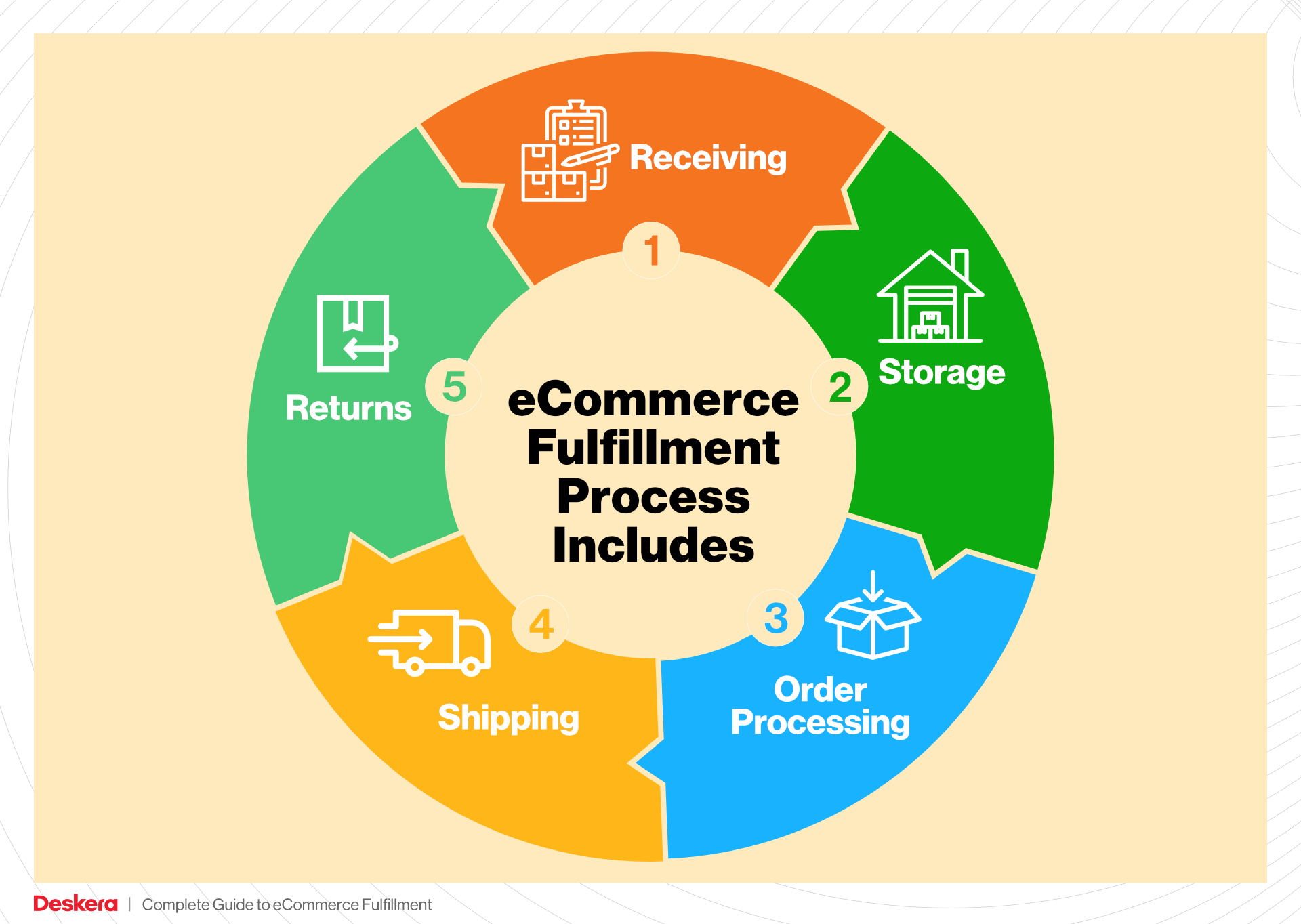
What You’ll Learn In This Guide
- What is E-commerce Fulfillment? An Introduction for Growing Businesses
- The Order Fulfillment Process: From ‘Buy’ Button to Customer’s Door
- Comparing Fulfillment Models: In-House vs. 3PL vs. Dropshipping
- A Deep Dive into Amazon FBA: Pros, Cons, and Who It’s For
- Core Services Offered by Fulfillment Centers
- How to Choose a Fulfillment Partner: A 6-Point Checklist
- Understanding Fulfillment Pricing: A Breakdown of Common Fees
- Frequently Asked Questions (FAQs) about Fulfillment
- Conclusion: Is Outsourcing Fulfillment the Right Move for Your Business?
- Important Disclaimer
The Order Fulfillment Process: From ‘Buy’ Button to Customer’s Door
1. Receiving Inventory
The first step in the order fulfillment process is receiving inventory. This involves accepting products from suppliers and ensuring that they match the purchase order in terms of quantity and quality. Each item is assigned a Stock Keeping Unit (SKU), which is a unique identifier that helps track inventory efficiently.
Importance: Accurate receiving is crucial because it lays the foundation for the entire fulfillment process. If discrepancies occur at this stage, it can lead to stockouts, overstocking, and ultimately dissatisfied customers. Moreover, proper inventory management allows businesses to maintain optimal stock levels, reducing carrying costs.
Key Term: SKU (Stock Keeping Unit) – A unique identifier for each product that simplifies inventory management and tracking.
2. Warehouse Storage
Once the inventory is received and verified, it needs to be stored in a warehouse. This step involves organizing products in designated storage locations, which can include shelves, bins, or pallets, depending on the size and type of items. Effective warehouse layout and inventory management software can optimize storage space and enhance retrieval efficiency.
Importance: Proper storage is essential for maintaining product integrity and ensuring that items are easily accessible when orders are placed. A well-organized warehouse minimizes the time spent searching for products, which can significantly affect overall fulfillment speed.
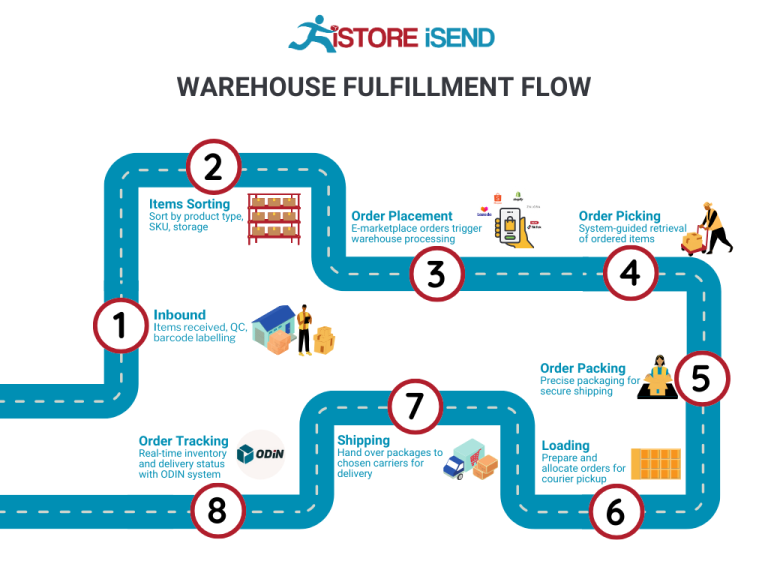
Key Term: FIFO (First In, First Out) – A method of inventory management that ensures the oldest stock is sold first, reducing the risk of obsolescence.
3. Order Picking
Order picking is the process of selecting items from the warehouse to fulfill customer orders. This step can be performed manually or with the help of automated systems, depending on the scale of operations. Pick lists, which are generated based on customer orders, guide warehouse staff in retrieving the correct items.
Importance: Efficient order picking is critical to maintaining fast fulfillment times. The quicker and more accurately items are picked, the faster the order can be processed and shipped. Errors during this stage can lead to incorrect orders, which negatively impacts customer satisfaction and increases return rates.
Key Term: Pick List – A document or digital tool that lists the items to be picked for a specific order, facilitating organized retrieval.
4. Order Packing
After items are picked, they proceed to the packing stage. This involves carefully packaging the products to ensure they are protected during transit. Packing materials may include boxes, bubble wrap, and packing peanuts. Additionally, packing slips are often included to provide customers with a summary of their order.
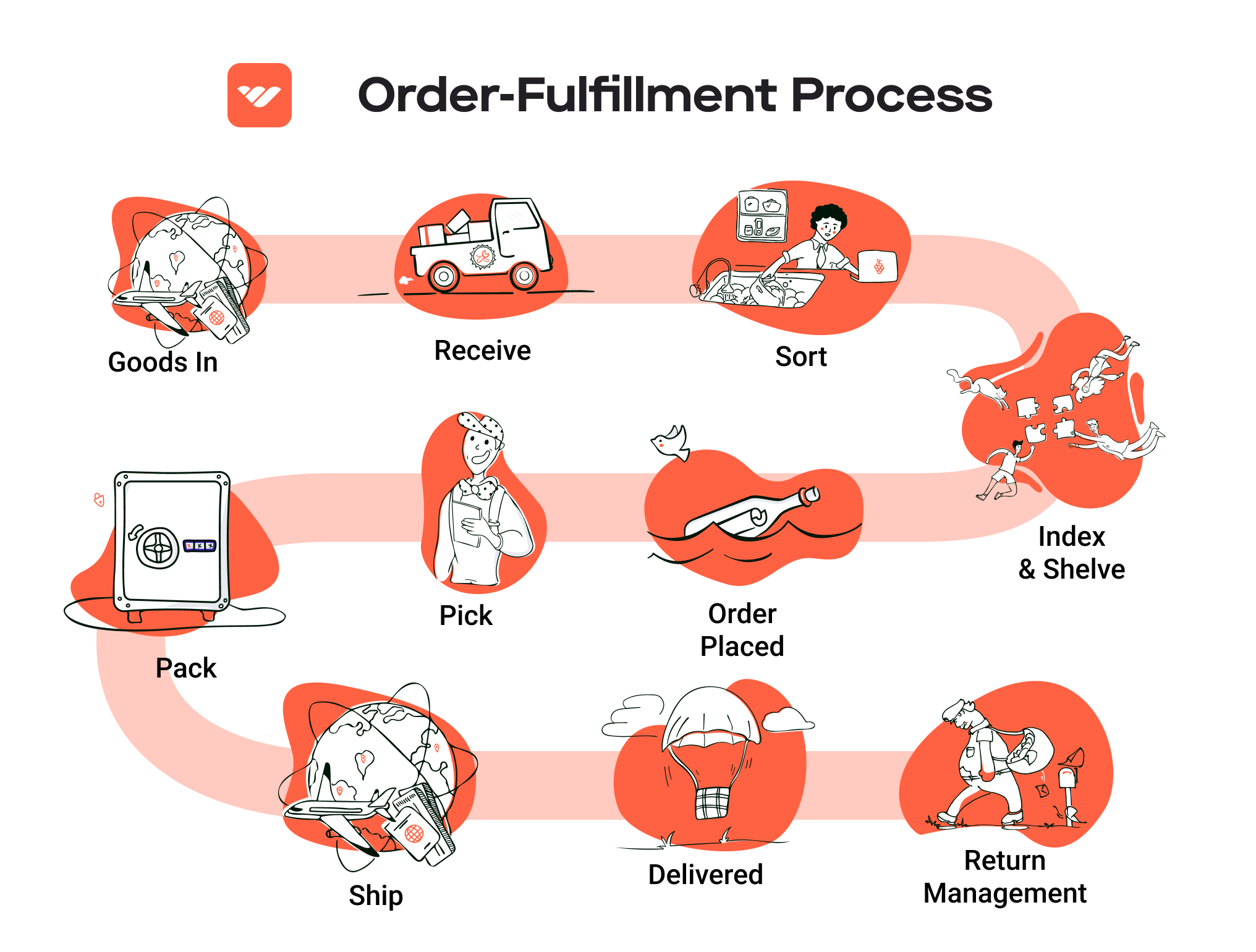
Importance: Proper packing is vital for preventing damage during shipping and ensuring that the order arrives in excellent condition. It also plays a role in the branding of the business; attractive and professional packaging can enhance customer perception and encourage repeat purchases.
Key Term: Packing Slip – A document included in the package that outlines the items within, serving as both a receipt for the customer and a record for the seller.
5. Shipping & Delivery
The final step in the order fulfillment process is shipping and delivery. Once packages are packed, they are labeled and handed over to carriers for transportation. This stage involves selecting the most efficient shipping method based on cost, delivery speed, and destination. Tracking systems are often employed to provide real-time updates to customers regarding their shipment status.
Importance: Timely delivery is a key factor in customer satisfaction. In today’s competitive e-commerce landscape, customers expect quick and reliable shipping. Efficient shipping processes not only enhance customer experiences but also contribute to repeat business and positive reviews.
Key Term: Last Mile Delivery – The final step of the shipping process where the package is delivered from a transportation hub to the final destination, often considered the most critical part of logistics.
By understanding and optimizing each of these steps in the order fulfillment process, e-commerce businesses can significantly improve their operational efficiency, enhance customer satisfaction, and ultimately drive growth.
Comparing Fulfillment Models: In-House vs. 3PL vs. Dropshipping
Fulfillment Model Comparison Table
| Model | Who Handles Inventory | Best For (Business Stage) | Key Advantage | Key Disadvantage |
|---|---|---|---|---|
| In-House Fulfillment | Business itself | Established businesses with stable sales | Full control over inventory and fulfillment processes | High overhead costs and resource commitment |
| Third-Party Logistics (3PL) | Third-party provider | Growing businesses looking to scale | Flexibility and scalability without heavy investment | Potential loss of control over customer experience |
| Dropshipping | Supplier | Startups and small businesses | Low upfront investment and minimal risk | Lower profit margins and reliance on suppliers |
In-House Fulfillment
In-house fulfillment is a model where the business manages all aspects of inventory and order fulfillment within its own facilities. This includes storing products, packing orders, and shipping them directly to customers. This model is ideal for established businesses that have stable sales volumes and can afford the resources required to maintain an efficient fulfillment operation. The primary advantage of in-house fulfillment is the complete control it offers over inventory management, quality assurance, and customer service. Businesses can tailor their fulfillment processes to meet specific needs, ensuring a personalized experience for their customers.
However, in-house fulfillment comes with significant disadvantages. The overhead costs can be substantial, as it requires investment in warehousing, staff, and technology to manage operations effectively. Additionally, the commitment of resources can be a drawback, especially if sales fluctuate or if the business seeks to pivot or expand into new product lines. For many businesses, the operational complexity can become overwhelming, detracting from core activities like marketing and product development.
Third-Party Logistics (3PL)
Third-party logistics (3PL) involves outsourcing the fulfillment process to an external provider that specializes in logistics and supply chain management. These providers handle inventory storage, order processing, and shipping, allowing businesses to focus on their core competencies. This model is particularly beneficial for growing businesses that are looking to scale without the burden of investing heavily in their own logistics infrastructure. The key advantage of using a 3PL is the flexibility it provides; businesses can quickly adjust their logistics needs based on demand fluctuations without incurring significant capital expenses.
However, the reliance on a 3PL can lead to potential downsides. One major concern is the possible loss of control over the customer experience. Since the 3PL manages order fulfillment, any issues with shipping delays or errors may reflect poorly on the business rather than the logistics provider. Additionally, there can be hidden costs associated with 3PL services, such as fees for storage, handling, and shipping, which can erode profit margins. Businesses must also ensure that the 3PL provider aligns with their brand values and service expectations to maintain a consistent customer experience.
Dropshipping
Dropshipping is a fulfillment model where the retailer does not keep the products it sells in stock. Instead, when a customer places an order, the retailer purchases the item from a third-party supplier who ships it directly to the customer. This model is particularly advantageous for startups and small businesses due to its low upfront investment and minimal risk. Since there is no need to purchase inventory upfront, businesses can test new products without significant financial commitment, allowing for agile responses to market demand.
However, dropshipping comes with its own set of challenges. The most significant disadvantage is the lower profit margins typically associated with this model, as retailers rely on suppliers to set prices. Moreover, businesses are at the mercy of their suppliers regarding stock availability, quality, and shipping times. This reliance can lead to inconsistent customer experiences, especially if suppliers fail to meet expectations. Additionally, managing returns and customer service can become complicated when the fulfillment process is outside the retailer’s control. As such, while dropshipping offers a low-risk entry into e-commerce, it requires careful management and a focus on building strong relationships with reliable suppliers.
Conclusion
When choosing a fulfillment model, e-commerce business owners must consider their specific needs, resources, and long-term goals. Each model—whether in-house fulfillment, 3PL, or dropshipping—has its own advantages and disadvantages that can impact operational efficiency, customer satisfaction, and ultimately, profitability. Understanding these differences is crucial for making informed decisions that align with the business’s growth trajectory and operational capabilities.
A Deep Dive into Amazon FBA: Pros, Cons, and Who It’s For
Understanding Fulfillment by Amazon (FBA)
Fulfillment by Amazon (FBA) is a service offered by Amazon that allows sellers to store their products in Amazon’s fulfillment centers. Amazon then takes care of storage, packaging, shipping, and customer service on behalf of the sellers. This service is designed to simplify the logistics of e-commerce for sellers, enabling them to focus on growing their business while leveraging Amazon’s vast distribution network.
How FBA Works
-
Product Storage: Sellers send their products to Amazon’s fulfillment centers. Once received, Amazon stores the items in their warehouses.
-
Order Processing: When a customer places an order for a product that is fulfilled by FBA, Amazon picks, packs, and ships the product directly to the customer.
-
Customer Service and Returns: Amazon handles all customer service inquiries and returns for FBA orders, providing sellers with peace of mind and allowing them to focus on scaling their business.
-
Shipping Options: Products fulfilled by Amazon are eligible for Prime shipping, offering customers fast delivery options, which can enhance the likelihood of purchase.
-
Multi-Channel Fulfillment: Sellers can also use FBA to fulfill orders from other sales channels, not just Amazon.com, broadening their reach and simplifying logistics.
Pros of Using FBA
-
Prime Eligibility: Products fulfilled by Amazon become eligible for Amazon Prime, which attracts millions of Prime members who prefer fast, free shipping. This can significantly boost sales, as Prime members are often more likely to purchase items that qualify for their membership benefits.
-
Customer Trust: Leveraging Amazon’s brand reputation can increase customer trust. When customers see the “Fulfilled by Amazon” label, they may feel more confident in their purchase due to Amazon’s established reliability in handling orders and customer service.
-
Efficient Logistics: Amazon’s extensive fulfillment network allows sellers to tap into a well-oiled logistics machine. The efficiency of their operations means faster processing times, which can lead to improved customer satisfaction and reduced handling times.
-
Scalability: FBA enables sellers to scale their businesses without the need for extensive infrastructure. As demand for products grows, sellers can simply send more inventory to Amazon rather than managing their own warehousing and logistics.
-
Multi-Channel Fulfillment: FBA allows sellers to fulfill orders from various platforms (e.g., eBay, Shopify) using the same inventory stored in Amazon’s warehouses. This integration simplifies inventory management and streamlines operations.
Cons of Using FBA
-
High Fees: While FBA can provide significant benefits, it also comes with costs. Sellers face various fees, including storage fees for items stored in Amazon’s warehouses and fulfillment fees for each order. These can add up, especially for sellers with lower margins.
-
Strict Inventory Rules: Amazon has stringent guidelines regarding inventory management, including restrictions on the types of products that can be stored and how long items can remain in their warehouses. Non-compliance can lead to additional fees or the removal of inventory.
-
Commingling Risks: FBA utilizes a system called commingling, where inventory from different sellers may be stored together. This can lead to issues if a seller’s product is damaged or if a customer receives the wrong item. Sellers may also face challenges in tracking their specific inventory.
-
Less Control: By outsourcing fulfillment to Amazon, sellers relinquish some control over the packaging and shipping processes. This can affect brand perception, as packaging may not align with the seller’s branding.
-
Dependence on Amazon: Relying heavily on FBA can make sellers vulnerable to changes in Amazon’s policies or fee structures. As the marketplace evolves, sellers may need to adapt quickly to maintain profitability.
Who is FBA Best For?
Fulfillment by Amazon is particularly well-suited for:
-
Small to Medium-Sized Businesses: Sellers looking to scale without investing heavily in logistics can benefit from FBA’s infrastructure. It allows them to focus on marketing and product development rather than warehousing and shipping.
-
Entrepreneurs Launching New Products: New sellers or those introducing new products may find FBA advantageous as it reduces the complexity of logistics, allowing them to test market demand without significant upfront investment in fulfillment capabilities.
-
E-commerce Brands Seeking Efficiency: Brands that prioritize speed and reliability in their shipping processes can leverage FBA to enhance customer satisfaction and reduce operational headaches.
-
Sellers with Seasonal Products: Businesses that experience seasonal spikes in demand can use FBA to manage inventory fluctuations without committing to long-term storage solutions.
-
Multi-Channel Sellers: Businesses selling on multiple platforms can streamline their operations by utilizing FBA for all fulfillment needs, allowing for consistent service levels across various sales channels.
In summary, while Fulfillment by Amazon offers a powerful solution for e-commerce businesses looking to streamline logistics and enhance customer service, it is essential for sellers to carefully weigh the pros and cons. Understanding how FBA aligns with their business strategy and operational needs will determine its effectiveness in scaling their operations.
Core Services Offered by Fulfillment Centers
Inventory Management & Warehousing
Fulfillment centers provide robust inventory management and warehousing services that are essential for e-commerce businesses aiming to scale. This involves the systematic storage of products, tracking inventory levels, and ensuring that stock is available to meet customer demand. Advanced warehouse management systems (WMS) are typically employed to monitor inventory in real-time, which allows businesses to optimize their stock levels and reduce the risk of overstocking or stockouts.
The benefits of effective inventory management are multifaceted. First, it enhances operational efficiency by minimizing the time spent on manual inventory counts and order processing. Second, it aids in forecasting demand more accurately, which can lead to better purchasing decisions and reduced holding costs. Lastly, a well-organized warehouse layout improves order picking speed and accuracy, directly impacting customer satisfaction through timely and correct deliveries.
Pick and Pack Services
Pick and pack services are at the heart of fulfillment center operations. This service involves selecting products from the warehouse shelves based on customer orders (picking) and then packing those items securely for shipment (packing). Fulfillment centers utilize technology, such as barcode scanning and automated sorting systems, to streamline this process, ensuring that orders are fulfilled quickly and accurately.
The primary advantage of pick and pack services is the significant reduction in order processing time. For e-commerce businesses, speed is crucial; faster fulfillment translates to quicker shipping and improved customer experiences. Additionally, fulfillment centers often have the expertise and equipment necessary to handle complex orders, such as those requiring multiple items or special packaging. This scalability allows businesses to grow without being hampered by logistics challenges, making it easier to respond to spikes in demand, such as during sales events or holiday seasons.
Kitting and Assembly
Kitting and assembly services involve combining multiple products into a single package or preparing items for sale as a bundled offering. This can include assembling products that require some degree of setup or packaging items together to create promotional bundles. Fulfillment centers are equipped to handle these tasks efficiently, often employing skilled labor and specialized equipment to ensure quality.
The benefits of kitting and assembly are particularly relevant for e-commerce businesses looking to differentiate themselves in a competitive market. Offering bundled products can enhance perceived value and encourage larger purchases, ultimately driving higher sales. Additionally, kitting can simplify inventory management by reducing the number of individual SKUs businesses need to track. This streamlining can result in lower operational costs and improved cash flow as inventory turnover rates increase.
Returns Management (Reverse Logistics)
Returns management, or reverse logistics, is a critical service provided by fulfillment centers, particularly in the e-commerce space where return rates can be significant. This process involves managing product returns from customers, restocking items, and handling any necessary inspections or refurbishments. An efficient returns management system is vital for maintaining customer satisfaction and loyalty.
The benefits of effective returns management are substantial. For one, a streamlined returns process enhances the overall customer experience, making it easier for customers to return unwanted products. This can lead to higher customer retention rates, as shoppers are more likely to purchase from a brand that offers hassle-free returns. Furthermore, fulfillment centers can analyze return data to identify trends, such as frequent returns of specific products, which can inform product development and inventory decisions. By addressing the root causes of returns, businesses can improve product quality and customer satisfaction, ultimately enhancing their brand reputation.
Conclusion
In summary, fulfillment centers play a pivotal role in the success of e-commerce businesses by offering core services such as inventory management and warehousing, pick and pack services, kitting and assembly, and returns management. Each of these services provides distinct advantages that help streamline operations, reduce costs, and improve customer satisfaction. By leveraging these capabilities, businesses can focus on scaling their sales and expanding their market presence while leaving the complexities of logistics to the experts.
How to Choose a Fulfillment Partner: A 6-Point Checklist
Location & Warehouse Network
Importance: The geographical location of your fulfillment partner’s warehouses can significantly impact shipping times and costs. A partner with warehouses strategically located near your primary customer base can enhance delivery speed and reduce transportation expenses.
Questions to Ask:
– Where are your warehouses located, and how do they relate to our target markets?
– What is the average shipping time from your warehouses to key locations?
– Do you have a network of warehouses that can support multi-channel distribution?
Technology & Integrations
Importance: Advanced technology and seamless integrations are crucial for efficient operations. A partner that utilizes modern warehouse management systems (WMS) can streamline processes, improve order accuracy, and enhance inventory management.
Questions to Ask:
– What technology platforms do you use for inventory management, order processing, and shipping?
– How do your systems integrate with our e-commerce platform (e.g., Amazon, Shopify)?
– Do you offer real-time tracking and reporting capabilities for inventory and shipments?
Specializations (e.g., Cold Storage, Oversized Items)
Importance: Depending on your product types, you may require a fulfillment partner with specific capabilities, such as cold storage for perishable items or facilities designed for oversized goods. Understanding these specializations can prevent logistical challenges and ensure compliance with regulations.
Questions to Ask:
– Do you have specialized facilities for our product types (e.g., temperature-controlled storage, hazardous materials)?
– What experience do you have with handling our specific product categories?
– Can you accommodate fluctuations in inventory levels for seasonal products?
Scalability & Capacity
Importance: As your business grows, your fulfillment needs will evolve. A partner that can scale operations quickly and efficiently is essential to support your growth without compromising service quality.
Questions to Ask:
– What is your current capacity, and how do you manage peak seasons or unexpected surges in demand?
– Can you easily adjust staffing and resources based on our changing needs?
– Do you have a plan in place for expanding your warehouse capabilities if necessary?
Pricing and Contracts
Importance: Understanding the pricing structure and contract terms is vital for budgeting and financial planning. Transparent pricing helps avoid unexpected costs and ensures that you can maintain profitability as you scale.
Questions to Ask:
– What is included in your pricing structure (e.g., storage fees, picking and packing fees, shipping costs)?
– Are there any additional charges we should be aware of (e.g., for returns or special handling)?
– What are the terms of your contract, and is there flexibility for renegotiation as our needs change?
Customer Support & Reviews
Importance: Reliable customer support is crucial for resolving issues quickly and maintaining operational efficiency. Additionally, reviews and testimonials from other clients provide insight into the partner’s reliability and service quality.
Questions to Ask:
– What support channels do you offer (e.g., phone, email, live chat), and what are your response times?
– Can you provide references or case studies from clients in our industry?
– How do you handle issues like order discrepancies, delays, or inventory shortages?
Conclusion
Choosing the right fulfillment partner is a critical decision that can influence your business’s efficiency, customer satisfaction, and growth potential. By carefully evaluating these six key areas—location and warehouse network, technology and integrations, specializations, scalability and capacity, pricing and contracts, and customer support—you can make an informed choice that aligns with your operational needs and business goals. Be thorough in your assessment and ensure that your selected partner can adapt as your business evolves, providing the necessary support for your success in the competitive e-commerce landscape.
Understanding Fulfillment Pricing: A Breakdown of Common Fees
Initial Setup Fees
When partnering with a fulfillment center, the first cost you may encounter is the initial setup fee. This fee typically covers the administrative costs associated with onboarding your business, including account creation, integration with your e-commerce platform, and initial inventory setup. The amount can vary widely based on the complexity of your operations and the fulfillment center’s processes, ranging from a few hundred to several thousand dollars.
To calculate this fee, fulfillment centers often consider the following factors:
– Integration Complexity: The more complex the integration with your e-commerce system (e.g., Shopify, WooCommerce, Amazon), the higher the fee.
– Inventory Volume: A larger volume of initial inventory may require more extensive setup efforts, increasing the fee.
– Customization Needs: If you require specialized services (e.g., custom packaging or labeling), this will also contribute to the initial cost.
Receiving Fees
Receiving fees are charged each time your inventory arrives at the fulfillment center. These fees cover the costs associated with unloading, inspecting, and storing your products. Most fulfillment centers charge a per-unit fee, which can vary based on the type and size of the items being received.
Factors influencing receiving fees include:
– Volume of Inventory: Larger shipments may incur a lower per-unit cost due to economies of scale.
– Item Size and Weight: Heavier or bulkier items may attract higher fees due to the additional handling required.
– Inspection Requirements: If your products need quality checks or repackaging upon arrival, this can increase the receiving fees.
Storage Fees (per pallet/bin)
Storage fees are ongoing costs associated with keeping your inventory in the fulfillment center. These fees can be charged monthly and are typically based on the space your products occupy, measured in pallets or bins. The rates can vary significantly depending on the location of the fulfillment center and market demand.
Here’s how storage fees are generally calculated:
– Size of the Inventory: The more space your products take up, the higher the storage fee.
– Duration of Storage: Most fulfillment centers charge for the time your inventory remains in their warehouse; longer storage periods can lead to increased costs.
– Seasonal Variations: Some centers may increase their storage fees during peak seasons (e.g., holidays) due to higher demand for space.
Pick & Pack Fees (per item/order)
Pick and pack fees are incurred each time an order is fulfilled. These fees cover the costs of selecting items from inventory, packing them for shipment, and preparing them for delivery. The fee structure can be either per item or per order, depending on the fulfillment center’s pricing model.
The calculation of pick and pack fees often considers:
– Number of Items per Order: More items typically result in higher fees, especially if they require different picking and packing processes.
– Complexity of Packing: Custom packaging or special handling requirements can increase the overall cost.
– Efficiency of Operations: Centers with more streamlined processes may offer lower fees compared to those with manual handling.
Shipping Fees
Shipping fees are one of the most significant costs associated with fulfillment services. These fees cover the transportation of your products from the fulfillment center to the customer. Shipping costs can vary based on several factors, including distance, shipping method (standard, expedited, etc.), and the size and weight of the package.
Shipping fees are typically calculated based on:
– Destination: Longer distances generally incur higher shipping costs.
– Weight and Dimensions: Heavier and larger packages often attract higher fees due to carrier pricing structures.
– Carrier Rates: Different carriers (e.g., UPS, FedEx, USPS) have varying rates, and fulfillment centers may have negotiated discounts that can affect your costs.
Tips for Getting an Accurate Quote
To ensure you receive an accurate quote from a fulfillment center, consider the following tips:
- Clearly Define Your Needs: Provide detailed information about your products, expected order volumes, and any special handling requirements.
- Ask for a Breakdown of Costs: Request a comprehensive breakdown of all fees, including any potential additional charges that may arise.
- Inquire About Discounts: Many fulfillment centers offer volume discounts or seasonal promotions. Don’t hesitate to ask about these opportunities.
- Evaluate Multiple Providers: Obtain quotes from several fulfillment centers to compare pricing and services. This will help you identify the best value for your business.
- Review Contracts Carefully: Ensure you understand the terms and conditions associated with fees, especially regarding storage duration and any penalties for exceeding limits.
By understanding these common fees and carefully evaluating your options, you can make informed decisions that will help scale your e-commerce operations effectively.
Frequently Asked Questions (FAQs) about Fulfillment
1. Where is the Amazon Fulfillment Center located in Kansas City?
The Amazon Fulfillment Center in Kansas City is located at 5414 Southern Rd, Kansas City, MO 64120. This facility plays a vital role in the distribution network, allowing for efficient storage, packing, and shipping of a wide variety of products.
2. What services does the Amazon Fulfillment Center in Kansas City provide?
The Kansas City Fulfillment Center specializes in storing, packing, and shipping products for Amazon sellers. It utilizes advanced technology and logistics systems to ensure timely and accurate order fulfillment, contributing to Amazon’s reputation for quick delivery.
3. What is the difference between a warehouse and a fulfillment center?
A warehouse primarily focuses on storing goods for long periods, while a fulfillment center is designed to process and ship orders quickly. Fulfillment centers are equipped with technology for inventory management, order processing, and shipping logistics, making them ideal for e-commerce businesses needing fast turnaround times.
4. How does Amazon’s fulfillment process work?
When a customer places an order on Amazon, the fulfillment process begins at the center. The ordered product is picked from inventory, packed securely, and labeled for shipment. Amazon then arranges for delivery through its logistics network, ensuring that the package reaches the customer promptly.
5. What is a 3PL (Third-Party Logistics)?
A 3PL is a service provider that handles logistics and supply chain management on behalf of another company. This can include warehousing, transportation, and order fulfillment. Many e-commerce businesses use 3PLs to outsource their logistics needs, allowing them to focus on other aspects of their operations.
6. How much do fulfillment services cost?
Fulfillment service costs vary based on factors like the volume of orders, storage space required, and the complexity of the services needed. On average, businesses can expect to pay for storage fees, picking and packing fees, and shipping costs. It’s essential to obtain quotes from multiple providers to find a service that fits your budget.
7. What types of products can be stored at the Kansas City Fulfillment Center?
The Amazon Fulfillment Center in Kansas City can accommodate a wide range of products, including electronics, clothing, household goods, and more. However, there are restrictions on certain items, such as hazardous materials or perishables, so it’s important to verify with Amazon’s guidelines.
8. How can businesses benefit from using the Kansas City Fulfillment Center?
Utilizing the Kansas City Fulfillment Center allows businesses to leverage Amazon’s extensive logistics network, ensuring faster shipping and improved customer satisfaction. It also enables sellers to scale their operations without the need for significant investment in warehousing and staffing.
9. Are there any requirements for selling through the Kansas City Fulfillment Center?
Yes, to sell through the Kansas City Fulfillment Center, businesses must register for an Amazon seller account and comply with Amazon’s policies and requirements. This includes adhering to product guidelines, ensuring quality standards, and managing inventory effectively.
10. What support does Amazon provide to sellers using its fulfillment centers?
Amazon offers various resources and tools for sellers using its fulfillment centers, including training materials, seller support, and access to performance analytics. These resources help sellers optimize their operations and improve their fulfillment strategies, ultimately leading to increased sales.
Conclusion: Is Outsourcing Fulfillment the Right Move for Your Business?
Evaluating the Benefits of Outsourcing Fulfillment
Outsourcing fulfillment can be a transformative decision for e-commerce businesses looking to scale efficiently. By leveraging the capabilities of specialized fulfillment centers, such as those offered by Amazon in Kansas City, companies can unlock several key benefits that directly contribute to operational efficiency and overall growth.
First and foremost, outsourcing fulfillment saves valuable time. Instead of dedicating resources to manage inventory, packing, and shipping logistics, business owners can focus on core competencies like product development, marketing, and customer engagement. This shift in focus often leads to enhanced innovation and improved customer experiences, which are critical for maintaining a competitive edge in the e-commerce landscape.
Scalability is another significant advantage. As your business grows, so do the complexities of managing fulfillment. A reliable fulfillment partner can seamlessly adapt to increased order volumes without the need for substantial investment in infrastructure or personnel. This flexibility allows businesses to respond swiftly to market demands and seasonal fluctuations, ensuring that customer satisfaction remains high.
Moreover, fulfillment centers bring a wealth of expertise. With established systems and advanced technology, these partners can optimize the fulfillment process, reduce errors, and enhance delivery speed. This expertise not only improves operational efficiency but also helps businesses maintain their reputation for reliability in the eyes of customers.
However, the success of outsourcing fulfillment hinges on selecting the right partner. It is essential to evaluate potential fulfillment centers based on their capabilities, technology, and alignment with your business goals. A well-chosen partner can propel your growth, while the wrong choice may lead to complications and customer dissatisfaction.
Take Action
To determine if outsourcing fulfillment is the right next step for your business, conduct a thorough audit of your current shipping processes. Assess your pain points, capacity for growth, and the time spent on logistics versus strategic initiatives. This evaluation will provide clarity on whether a fulfillment partner could enhance your operational efficiency and support your scaling ambitions.
Important Disclaimer
⚠️ Important Disclaimer
The information in this guide is for educational purposes. Fulfillment services, pricing, and platform features change frequently. Always conduct your own due diligence and consult with providers directly before making business decisions.
